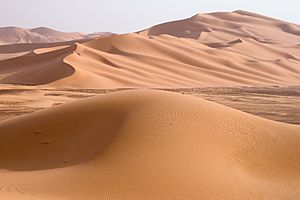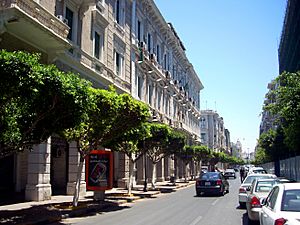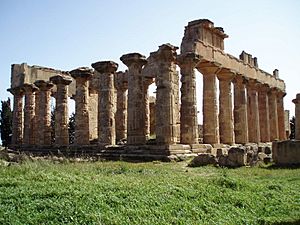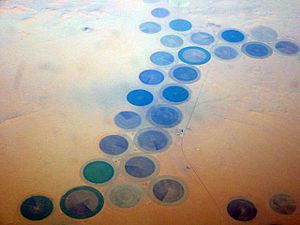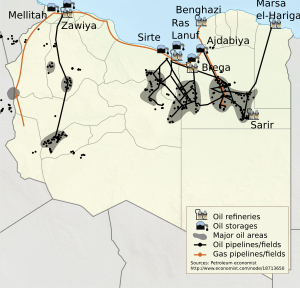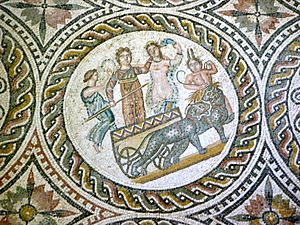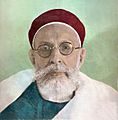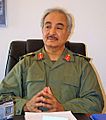Libya facts for kids
Quick facts for kids
State of Libya
|
|
|---|---|
|
|
|
|
Anthem: ليبيا، ليبيا، ليبيا
"Libya, Libya, Libya" |
|
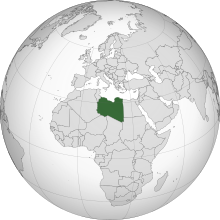
Location of Libya (dark green) in northern Africa
|
|
| Capital and largest city
|
Tripoli 32°52′N 13°11′E / 32.867°N 13.183°E |
| Official languages | Arabic |
| Local vernacular | Libyan Arabic |
| Ethnic groups
(1999)
|
|
| Religion
(2020)
|
|
| Demonym(s) | Libyan |
| Government | Unitary republic under a provisional government |
|
• Chairman of the Presidential Council
|
Mohamed al-Menfi |
|
• Vice Chairman of the Presidential Council
|
Musa Al-Koni |
| Abdul Hamid Dbeibeh | |
| Legislature | House of Representatives |
| Establishment | |
|
• Regency of Tripoli
|
15 August 1551 |
| 5 November 1911 | |
|
• Independence declared
|
10 February 1947 |
|
• Kingdom established
|
24 December 1951 |
|
• Coup d'état by Muammar Gaddafi
|
1 September 1969 |
|
• Socialist People's Libyan Arab Jamahiriya
|
2 March 1977 |
| 17 February 2011 | |
|
• NATO intervention in Libya
|
19 March 2011 |
| 23 October 2020 | |
| Area | |
|
• Total
|
1,759,541 km2 (679,363 sq mi) (16th) |
| Population | |
|
• 2024 estimate
|
7,361,263 (103rd) |
|
• Density
|
4.184/km2 (10.8/sq mi) (218th) |
| GDP (PPP) | 2024 estimate |
|
• Total
|
|
|
• Per capita
|
|
| GDP (nominal) | 2024 estimate |
|
• Total
|
|
|
• Per capita
|
|
| HDI (2022) | high · 92nd |
| Currency | Libyan dinar (LYD) |
| Time zone | UTC+2 (EET) |
| Driving side | right |
| Calling code | +218 |
| ISO 3166 code | LY |
| Internet TLD | .ly ليبيا. |
|
|
Libya (Arabic: ليبيا Lībyā, Berber: ⵍⵉⴱⵢⴰ Libya), officially the State of Libya, is a country in North Africa. It is bordered by the Mediterranean Sea to the north, Egypt to the east, Sudan to the southeast, Chad and Niger to the south, and Algeria and Tunisia to the west. It covers an area of almost 1.8 million square kilometres (700,000 sq mi). It is the 17th largest country in the world.
Contents
History
Libya has been inhabited by Berbers since the late Bronze Age as descendants from Iberomaurusian and Capsian cultures. In classical antiquity, the Phoenicians established city-states and trading posts in western Libya, while several Greek cities were established in the East. Parts of Libya were variously ruled by Carthaginians, Persians, and Greeks before the entire region becoming a part of the Roman Empire. Libya was an early center of Christianity. After the fall of the Western Roman Empire, the area of Libya was mostly occupied by the Vandals until the 7th century when invasions brought Islam to the region. From then on, centuries of Arab migration to the Maghreb shifted the demographic scope of Libya in favor of Arabs. In the 16th century, the Spanish Empire and the Knights of St John occupied Tripoli until Ottoman rule began in 1551. Libya was involved in the Barbary Wars of the 18th and 19th centuries. Ottoman rule continued until the Italo-Turkish War, which resulted in the Italian occupation of Libya and the establishment of two colonies, Italian Tripolitania and Italian Cyrenaica (1911–1934), later unified in the Italian Libya colony from 1934 to 1943.
During the Second World War, Libya was an area of warfare in the North African Campaign. The Italian population then went into decline.
United Kingdom of Libya
After World War II, the regions of Libya were ruled by military governors from both Britain and France. The United Nations made Libya an independent country, the United Kingdom of Libya, in 1951. This was to be a constitutional monarchy, ruled by King Idris I and his successors. Idris (Muhammad Idris bin Muhammad al-Mahdi as-Senussi) (13 March 1890—25 May 1983) had been the Emir of Cyrenaica, but went into exile in Egypt in 1922. At the end of the war, he returned as emir, with support of Britain. He was also asked to be Emir of Tripolitania. He was able to unite the three regions and became the king of the United Kingdom of Libya on 24 December 1951.
The problems facing Libya were huge. The country was poor, with little in the way of goods to export. Only 250,000 people could read. There were only 16 Libyan college graduates, no Libyan doctors, engineers, pharmacists, or surveyors. The United Nations estimated that 10% of the people were blind from eye diseases, especially trachoma. Idris was a religious leader did not take much interest in the affairs of government. His government was seen to be corrupt, and did nothing about an increasing rise in Arab nationalism which had brought Nasser to power in Egypt in 1952. Once oil was discovered, Libya became one of the largest oil producing countries in the world. Many Libyans felt that Cyrenaica was getting more of the oil money than the rest of the country. A lot of the money from oil was also going to overseas companies.
Libyan Arab Republic
In the early morning of 1 September 1969, a group of military officers took over the government in a coup d'état. Colonel Muammar al-Gaddafi was named as chief of staff of the military. From 1970-1972 he served as Prime Minister. He began a political system named "The Third Universal Theory". This is a mix of socialism and Islam, based on tribal government. It was to be put in place by the Libyan people themselves in a unique form of "direct democracy." Al-Gaddafi called this "jamahiriya".
Some of his first actions were to take back control of the oil and send the remaining Italian settlers back to Italy. He also closed down the American USAF base.
Great Socialist People's Libyan Arab Jamahiriya
In 1977 Libya became "Al-Jamahiriya al-`Arabiyah al-Libiyah ash-Sha`biyah al-Ishtirakiyah al-Uzma" . In English, the name means the "Great Socialist People's Libyan Arab Jamahiriya".
Libya was alleged to have sponsored anti-western groups. Gaddafi openly supported independence movements like Nelson Mandela's African National Congress, Palestinian Liberation Organization, the Irish Republican Army, the Polisario Front (Western Sahara) and more. Because of this Libya's foreign relations with several western nation were negatively effected, and it would become a reason for US to bomb Libya in 1986. Gaddafi survived the bombing, the action of US was condemned by many countries and UN general assembly.
Libya had also supplied weapons and money to the Irish Republican Army during its fight with the British government in Northern Ireland. Gaddafi developed a good relationship with revolutionary Colombian Marxist–Leninist guerrilla group called FARC. Activities also included such as Libyan contribution towards Falklands War, where Gaddafi had provided 20 launchers, 60 SA-7 missiles, machine guns, mortars and mines to the Argentinian government. Libya was alleged to have role in bombing of Pan Am Flight 103 over Lockerbie, Scotland in 1988 and French UTA Flight 772 in 1989, despite the investigation found no evidence which involves any Libyan role.
The United Nations put economic sanctions in place against Libya in 1992. These sanctions stopped other countries selling weapons, investing money, or even allowing their people to visit Libya. After six days when US had captured Iraq's Saddam Hussein, Gaddafi renounced Libya's weapons of mass destruction programs and welcomed international inspections to verify that he would follow through on the commitment. Gaddafi said he hopes that other nations would follow his example. UN removed the sanctions in the same year. Gaddafi solved the Lockerbie plane crash issue by paying US$2.7 billion to the families of the victims. Prime Minister of Libya Shukri Ghanem, told in the interviews that Gaddafi was "paying the price for peace" with the West, and suggested that Libya had no role in the case. United Nations observers would acknowledge such statement and cast doubt towards the whole issue.
Gaddafi also set about having normal relations with other counties. Western European leaders and many working-level and commercial delegations were able to visit the country. He made his first trip to Western Europe in 15 years when he traveled to Brussels in April 2004. He reattached the ties with Russia once again, which had remained idle since the collapse of the Soviet Union.
Gaddafi was often described by critics as a dictator, and was one of the world's longest serving non-royal leaders, ruling for 42 years. He ruled until being overthrown and killed during the 2011 Libyan Civil War. By 2014 two rival authorities claimed to govern Libya, which led to a second civil war, with parts of Libya split between the Tobruk and Tripoli-based governments as well as various tribal and Islamist militias. The two main warring sides signed a permanent ceasefire in 2020, and a unity government took authority to plan for democratic elections, though political rivalries continue to delay this.
Geography
Libya's borders touch the countries of Egypt, Sudan, Chad, Algeria, Niger, and Tunisia. To its north is the Mediterranean Sea. The capital of Libya is Tripoli, which is a port on the sea. Tripoli has about one million people. Libya covers an area of about 1,760,000 km2 (679,540 sq mi).
The highest point in Libya is Bikku Bitti 2,267 m above sea level and the lowest point is Sabkhat Ghuzayyil -47 m at below sea level. Most of the country is flat, with large plains. Because it is so dry, only 1.03% of the land is suitable for farming.
The area around Tripoli is called Tripolitania, and it was the most developed during the Ottoman occupation.
Cyrenaica is an area of the north east coast. It is divided from Tripolitania by the Gulf of Sirte. It was named by the Greeks who built the city of Cirene in 630 BC. The area was where many of the battles of World War II were fought. It includes the cities of Tobruk and Benghazi. Like Tripolitania, Cyrenaica was also governed by Britain after the war.
The Fezzan is an area of desert in south west Libya which the Italians made a part of Tripoli in 1912. After the war this area was governed by France, who wanted to annex to their Empire.
Districts
Since 2007 Libya has been divided into 22 districts.
| Arabic | Transliteration | Pop (2006) | Land area (km2) | Number (on map) |
 |
|---|---|---|---|---|---|
| البطنان | Butnan | 159,536 | 83,860 | 1 | |
| درنة | Derna | 163,351 | 19,630 | 2 | |
| الجبل الاخضر | Jabal al Akhdar | 206,180 | 7,800 | 3 | |
| المرج | Marj | 185,848 | 10,000 | 4 | |
| بنغازي | Benghazi | 670,797 | 43,535 | 5 | |
| الواحات | Al Wahat | 177,047 | 6 | ||
| الكفرة | Kufra | 50,104 | 483,510 | 7 | |
| سرت | Sirte | 141,378 | 77,660 | 8 | |
| مرزق | Murzuq | 78,621 | 349,790 | 22 | |
| سبها | Sabha | 134,162 | 15,330 | 19 | |
| وادي الحياة | Wadi al Hayaa | 76,858 | 31,890 | 20 | |
| مصراتة | Misrata | 550,938 | 9 | ||
| المرقب | Murqub | 432,202 | 10 | ||
| طرابلس | Tripoli | 1,065,405 | 11 | ||
| الجفارة | Jafara | 453,198 | 1,940 | 12 | |
| الزاوية | Zawiya | 290,993 | 2,890 | 13 | |
| النقاط الخمس | Nuqat al Khams | 287,662 | 5,250 | 14 | |
| الجبل الغربي | Jabal al Gharbi | 304,159 | 15 | ||
| نالوت | Nalut | 93,224 | 16 | ||
| غات | Ghat | 23,518 | 72,700 | 21 | |
| الجفرة | Jufra | 52,342 | 117,410 | 17 | |
| وادي الشاطئ | Wadi al Shatii | 78,532 | 97,160 | 18 |
Cities
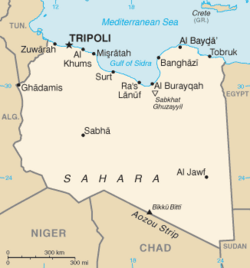
Economy
The Libyan economy depends primarily upon revenues from the oil sector, which account for over half of GDP and 97% of exports. Libya holds the largest proven oil reserves in Africa and is an important contributor to the global supply of light, sweet crude.
Libya faces many structural problems including a lack of institutions, weak governance, and chronic structural unemployment. Water supply is also a problem, with some 28% of the population not having access to safe drinking water in 2000.
The Great Man-Made River is the world's largest irrigation project. The project utilizes a pipeline system that pumps fossil water from the Nubian Sandstone Aquifer System from down south in Libya to cities in the populous Libyan northern Mediterranean coast including Tripoli and Benghazi. The water provides 70% of all freshwater used in Libya. During the second Libyan civil war, lasting from 2014 to 2020, the water infrastructure suffered neglect and occasional breakdowns.
Libya imports up to 90% of its cereal consumption requirements, and imports of wheat in 2012/13 was estimated at 1 million tonnes. The 2012 wheat production was estimated at 200,000 tonnes. The government hopes to increase food production to 800,000 tonnes of cereals by 2020. However, natural and environmental conditions limit Libya's agricultural production potential.
The country joined OPEC in 1962. Libya is not a WTO member.
In the early 1980s, Libya was one of the wealthiest countries in the world; its GDP per capita was higher than some developed countries.
By 2017, 60% of the Libyan population were malnourished. Since then, 1.3 million people are waiting for emergency humanitarian aid, out of a total population of 7.1 million.
Demographics
Libya is a large country with a relatively small population concentrated very narrowly along the coast. Its population density is about 50 inhabitants per square kilometre (130/sq mi) in the two northern regions of Tripolitania and Cyrenaica, but falls to less than 1 inhabitant per square kilometre (2.6/sq mi) elsewhere. Ninety percent of the people live along the coast in less than 10% of the area.
About 88% of the population is urban, mostly concentrated in the three largest cities, Tripoli, Benghazi and Misrata.
The population of Libya is primarily of Arab ancestry. Arabs comprise 92% of the population, while Berbers comprise 5%.
Because of this, their old ways of life are gradually fading out. An unknown small number of Libyans still live in the desert as their families have done for centuries. Most of the population has occupations in industry and services, and a small percentage is in agriculture.
Languages
The official language of Libya is Arabic. The local Libyan Arabic variety is spoken alongside Modern Standard Arabic. Various Berber languages are also spoken. In addition, English is widely understood in the major cities, while the former colonial language of Italian is also used in commerce and by the remaining Italian population.
Religion
About 97% of the population in Libya are Muslims, most of whom belong to the Sunni branch. Small numbers of Ibadi Muslims live in the country.
Culture
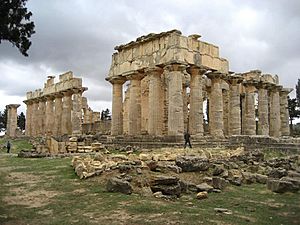
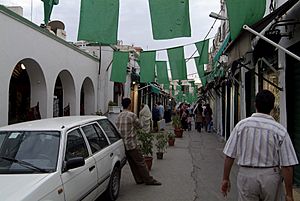
Many Arabic speaking Libyans consider themselves as part of a wider Arab community. This was strengthened by the spread of Pan-Arabism in the mid-20th century, and their reach to power in Libya where they instituted Arabic as the only official language of the state. Under Gaddafi's rule, the teaching and even use of indigenous Berber language was strictly forbidden. In addition to banning foreign languages previously taught in academic institutions, leaving entire generations of Libyans with limitations in their comprehension of the English language. Both the spoken Arabic dialects and Berber, still retain words from Italian, that were acquired before and during the Libia Italiana period.
Libyans have a heritage in the traditions of the previously nomadic Bedouin Arabic speakers and sedentary Berber tribes. Most Libyans associate themselves with a particular family name originating from tribal or conquest based heritage.
Reflecting the "nature of giving" (Arabic: الاحسان Ihsan, Berber languages: ⴰⵏⴰⴽⴽⴰⴼ Anakkaf ), amongst the Libyan people as well as the sense of hospitality, recently the state of Libya made it to the top 20 on the world giving index in 2013. According to CAF, in a typical month, almost three-quarters (72%) of all Libyans helped somebody they did not know – the third highest level across all 135 countries surveyed.
There are few theaters or art galleries due to the decades of cultural repression under the Qaddafi regime and lack of infrastructure development under the regime of dictatorship. For many years there have been no public theaters, and only very few cinemas showing foreign films. The tradition of folk culture is still alive and well, with troupes performing music and dance at frequent festivals, both in Libya and abroad.
A large number of Libyan television stations are devoted to political review, Islamic topics and cultural phenomena. A number of TV stations air various styles of traditional Libyan music. Tuareg music and dance are popular in Ghadames and the south. Libyan television broadcasts air programs mostly in Arabic though usually have time slots for English and French programs. A 1996 analysis by the Committee to Protect Journalists found Libya's media was the most tightly controlled in the Arab world during the country's dictatorship. As of 2012[update] hundreds of TV stations have begun to air due to the collapse of censorship from the old regime and the initiation of "free media".
Many Libyans frequent the country's beach and they also visit Libya's archaeological sites—especially Leptis Magna, which is widely considered to be one of the best preserved Roman archaeological sites in the world. The most common form of public transport between cities is the bus, though many people travel by automobile. There are no railway services in Libya, but these are planned for construction in the near future (see rail transport in Libya).
Libya's capital, Tripoli, has many museums and archives. These include the Government Library, the Ethnographic Museum, the Archaeological Museum, the National Archives, the Epigraphy Museum and the Islamic Museum. The Red Castle Museum located in the capital near the coast and right in the city center, built in consultation with UNESCO, may be the country's most famous.
Cuisine
Libyan cuisine is a mixture of the different Italian, Bedouin and traditional Arab culinary influences. Pasta is the staple food in the Western side of Libya, whereas rice is generally the staple food in the east.
Common Libyan foods include several variations of red (tomato) sauce based pasta dishes (similar to the Italian Sugo all'arrabbiata dish); rice, usually served with lamb or chicken (typically stewed, fried, grilled, or boiled in-sauce); and couscous, which is steam cooked whilst held over boiling red (tomato) sauce and meat (sometimes also containing courgettes/zucchini and chickpeas), which is typically served along with cucumber slices, lettuce and olives.
Bazeen, a dish made from barley flour and served with red tomato sauce, is customarily eaten communally, with several people sharing the same dish, usually by hand. This dish is commonly served at traditional weddings or festivities. Asida is a sweet version of Bazeen, made from white flour and served with a mix of honey, ghee or butter. Another favorite way to serve Asida is with rub (fresh date syrup) and olive oil. Usban is animal tripe stitched and stuffed with rice and vegetables cooked in tomato based soup or steamed. Shurba is a red tomato sauce-based soup, usually served with small grains of pasta.
A very common snack eaten by Libyans is known as khubs bi' tun, literally meaning "bread with tuna fish", usually served as a baked baguette or pita bread stuffed with tuna fish that has been mixed with harissa (chili sauce) and olive oil. Many snack vendors prepare these sandwiches and they can be found all over Libya. Libyan restaurants may serve international cuisine, or may serve simpler fare such as lamb, chicken, vegetable stew, potatoes and macaroni. Due to severe lack of infrastructure, many under-developed areas and small towns do not have restaurants and instead food stores may be the only source to obtain food products.
There are four main ingredients of traditional Libyan food: olives (and olive oil), dates, grains and milk. Grains are roasted, ground, sieved and used for making bread, cakes, soups and bazeen. Dates are harvested, dried and can be eaten as they are, made into syrup or slightly fried and eaten with bsisa and milk. After eating, Libyans often drink black tea. This is normally repeated a second time (for the second glass of tea), and in the third round of tea, it is served with roasted peanuts or roasted almonds known as shay bi'l-luz (mixed with the tea in the same glass).
Sport
Football is the most popular sport in Libya. The country hosted the 1982 African Cup of Nations and almost qualified for the 1986 FIFA World Cup. The national team almost won the 1982 AFCON; they lost to Ghana on penalties 7–6. In 2014, Libya won the African Nations Championship after beating Ghana in the finals. Although the national team has never won a major competition or qualified for a World Cup, there is still lots of passion for the sport and the quality of football is improving.
Horse racing is also a popular sport in Libya. It is a tradition of many special occasions and holidays.
Images for kids
-
The Atiq Mosque in Awjila is the oldest mosque in the Sahara.
-
The Siege of Tripoli in 1551 allowed the Ottomans to capture the city from the Knights of St. John.
-
The USS Enterprise of the Mediterranean Squadron capturing a Tripolitan Corsair during the First Barbary War, 1801
-
A US Navy expedition under Commodore Edward Preble engaging gunboats and fortifications in Tripoli, 1804
-
Omar Mukhtar was a prominent leader of Libyan resistance in Cyrenaica against Italian colonization.
-
King Idris I of the Senussi order became the first head of state of Libya in 1951.
-
Gaddafi (left) with Egyptian President Nasser in 1969
-
Libya has emerged as a major transit point for people trying to reach Europe
-
Field Marshal Khalifa Haftar, the head of the Libyan National Army, one of the main factions in the 2014 civil war.
-
Libyan men in Bayda.
See also
 In Spanish: Libia para niños
In Spanish: Libia para niños




